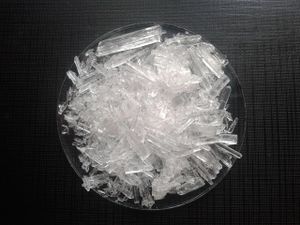Menthol

| |
| Names | |
|---|---|
| IUPAC name
(1R,2S,5R)-2-Isopropyl-5-methylcyclohexanol
| |
| Other names
3-p-Menthanol
5-methyl-2-(1-methylethyl)cyclohexanol Hexahydrothymol Menthomenthol Peppermint camphor | |
| Identifiers | |
| Jmol-3D images | Image |
| |
| Properties | |
| C10H20O | |
| Molar mass | 156.27 g/mol |
| Density | 0.890 g/cm3 (racemic or (−)-isomer) |
| Melting point | 36–38 °C (97–100 °F; 309–311 K) racemic 42–45°C, (-)-isomer, α crystalline form |
| Boiling point | 212 °C (414 °F; 485 K) |
| 1.35799 g/100 ml (at 25 °C)[1] | |
| Solubility | Soluble in glacial acetic acid, chloroform, diethyl ether, anhydrous ethanol, hexane, petroleum ether Slightly soluble in methanol |
| Solubility in methanol | 0.1 g/100 ml |
| Vapor pressure | 7.67x10-3 mmHg at 25 °C |
| Hazards | |
| Safety data sheet | ScienceLab |
| Flash point | 93 °C |
| Except where otherwise noted, data are given for materials in their standard state (at 25 °C [77 °F], 100 kPa). | |
| Infobox references | |
Menthol is an organic compound, found in various plants, such as peppermint, widely used in medicine and in food industry. Menthol is available as several isomers, with the (−)-menthol enantiomer form being the most common form in nature.
Contents
Properties
Chemical
Menthol can be oxidized with chromium trioxide to menthone. Diluted sulfuric acid dehydrates menthol to 3-menthene.
Physical
Menthol is a colorless, waxy crystalline solid at room temperature, with a strong pleasant smell. It is slightly soluble in water, but more so in organic solvents. There are many different values for the water solubility in literature, mostly due to the different racemic composition, as well as traces of other organic contaminants. Is is also soluble in glacial acetic acid, chloroform, diethyl ether, anhydrous ethanol, methanol (100 mg/ml), petroleum ether.
Availability
Menthol is sold by various chemical suppliers, and is available either as racemic mixture or as individual isomers.
Menthol is also sold in various pharmacies as an alcoholic solution, as a weak local anesthetic and counterirritant. It is also sold by soap and natural product companies, in pure crystalline form.
Menthol can be extracted form various plants, such as peppermint, though you will need a large amount of plant material to obtain useful quantities of menthol.
Preparation
Synthesizing menthol is a long and costly process, and you're better off extracting it from peppermint.
Projects
- Make beautiful large crystals
- Make an air freshener
- Make sodium metal
Handling
Safety
Menthol has low toxicity when inhaled, though it's best to avoid consuming large quantities of it.
Storage
Menthol should be stored in closed bottles, at temperatures lower than 35-40 °C. It can also be stored in the fridge.
Disposal
Menthol has low toxicity and can be poured down the drain, dumped in trash or poured in the soil.
References
- ↑ Ajisaka; Hara; Mikuni; Hashimoto; Bioscience, biotechnology, and biochemistry; vol. 64; nb. 4; (2000); p. 731 - 734
Sciencemadness Library
- The Chemistry of essential oils and perfumes vol I, by Ernest J. Parry, 1921
- The Chemistry of essential oils and perfumes vol II, by Ernest J. Parry, 1922
Relevant Sciencemadness threads
- Chemical pages without CAS Registry Number
- Articles without EBI source
- Chemical pages without ChemSpiderID
- Chemical pages without DrugBank identifier
- Articles without KEGG source
- Articles without InChI source
- Articles without UNII source
- Articles containing unverified chemical infoboxes
- Chemical compounds
- Organic compounds
- Alcohols
- Biologically-derived compounds
- Materials available as food grade
- Fragrant compounds